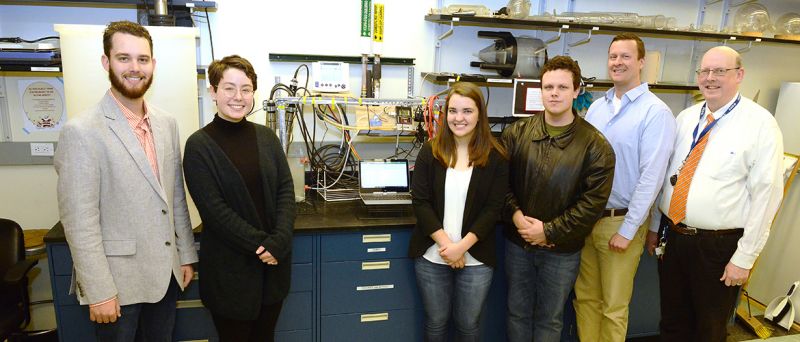Monitoring System for Efficient and Environmentally-friendly Water Management in Treatment Plants
Published on by Water Network Research, Official research team of The Water Network in Technology
Students in Oklahoma are developing a monitoring system that could help managers operate plants with less energy while still meeting environmental requirements.
Addressing water quality and quantity issues are complicated, especially in Oklahoma where water is a divisive issue. Providing clean water for drinking and enough water for agricultural, lawns and landscaping, recreational and industrial use are all hotly debated. But a concern that few people want to think about is how to treat wastewater efficiently and safely.

Representative Image Source: Pixabay, labeled for reuse
OSU’s Dr. Dave Lampert pays more attention to wastewater treatment plants, found in nearly every town in America, than just about anyone who relies on them. That is, until fish start dying in the stream behind their house or their utility bill spikes.
Most rate-paying residents don’t consider a plant’s operating cost, but the facility is required by law to protect water quality and human health, and treating wastewater is one of the most energy-hungry processes cities and towns handle.
“If you look at all the wastewater plants across the country, something like 14,000, wastewater treatment uses between 1 and 3 percent of all the electricity in the entire U.S.,” said Lampert, an assistant professor in the OSU School of Civil and Environmental Engineering. “That’s billions of dollars of electricity and using that much is an environmental issue all by itself.”
Lampert and his OSU graduate and undergraduate students in the College of Engineering, Architecture and Technology (CEAT) are developing a monitoring system that could help managers operate plants with less energy while still meeting environmental requirements. Recognizing the need, Lampert and colleagues in CEAT and the Spears School of Business are building a business. The system uses a computer program and sensors to watch the aeration part of the treatment process. Their technology is now being tested with some local assistance.
“Wastewater is everything that goes down your sink, your shower, and, most notably, your toilet,” said Rabecca Wiseman, a master’s student in environmental engineering who is leading the project. “In our lab we take real sewage from Stillwater's wastewater treatment plant, treat it, and monitor everything going on while it's being treated.”
The most expensive part of the process is aeration. A wastewater plant pumps air into sewage to support microorganisms that consume organic matter and pollutants. Those organisms require oxygen to do their job. Too little and they die, but too much leads to wasted energy, which is expensive and indirectly causes air pollution.
Adjusting aeration automatically in real time based on computer analysis would maintain an optimal level of oxygen and use the least amount of energy.
“Most wastewater treatment operators aerate at full capacity 24/7 because they have no way of knowing how ‘dirty’ the water is while it's being treated,” Wiseman said. “By implementing our algorithm into treatment plants, we can optimize the aeration process, saving a municipality up to $300,000 a year.”

The Lampert team includes (from left) students Brooks Robinson, Rabecca Wiseman, Madelyn Shaw, recent graduate Nick Overacker and Drs. Dave Lampert and James Stine. (Image Source: Oklahoma State University)
Lampert and his students have built a lab-scale wastewater treatment plant that sits on a countertop where they’re testing their innovation. The technology includes water-quality sensors to collect data on the treatment process, including amounts of phosphorous, dissolved oxygen, ammonia, nitrates and other material, at any given moment. The information is fed to computer algorithms created by Lampert and his team to automatically fine-tune the aeration process in real-time. Next, the engineers will build a larger version at the Stillwater, Oklahoma, wastewater treatment plant to test potential energy savings.
Though still early, developing a business around the technology has required a mix of faculty technical and business experts including Lampert, Dr. James Stine, professor of electrical engineering in CEAT, and Dr. David Thomison, a clinical assistant professor in the Riata School of Entrepreneurship in the Spears School of Business. The concept has attracted funding from the EPA, the OSU Technology Business Development Program, the National Science Foundation I-Corps program, the Oklahoma Center for the Advancement of Science and Technology and Venture Well.
The group’s business model focuses on the more than 12,000 municipal wastewater treatment plants that serve populations of 10,000 to 100,000. These facilities are likely to need the technology and expertise that Lampert and his team would provide. Currently, the plan is to charge municipalities a base fee of $3,000 per month plus $150 per million gallons treated daily.
Lampert estimates that electricity costs could be trimmed by as much as 45 percent in a city like Stillwater, saving the average operator $250,000 a year while paying for the OSU technology. Making that case will be the job of the business side of the collaboration.
“We have to show them that this is worth their investment,” Lampert said. “That’s where Dave (Thomison) on the business side comes in.”
Source: Oklahoma State University
Media
Taxonomy
- Wastewater Disposal
- Wastewater Use
- Combined Sewer
- Effluent
- Reclaimed Wastewater
- Sewage Treatment
- Wastewater Phycoremediation
- Raw Sewage Recycling
- Decentralized Wastewater
- Waste Water Treatments
- Treatment Plants
- Sensor Systems
- Wastewater Treatment
- Wastewater Collection
- Water Quality
- Hydrodynamics & Water Quality
- Data Management
- Remote Sensing & Data Analysis
- Sewage
- Water Quality Management
- Water Quality Training
- Wastewater Treatment Plant Design
- Sewer Networks
- Multi-Sensor Pipelines
- Waste Water Serviceability
- Groundwater Quality & Quantity
- Waste Water Treatment
- Water quality
- Data & Analysis
- Water Quality Research
- Water Sensitive Design and Planning